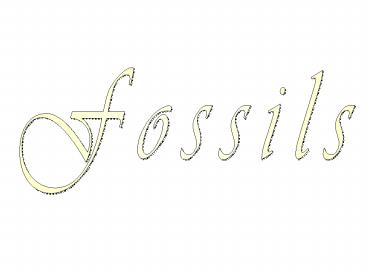Fossils - PowerPoint PPT Presentation
1 / 21
Title:
Fossils
Description:
What are fossils? The remains, imprints or traces of an organism that lived long ago. Preserved in rock. Typically sedimentary rock Must be buried quickly Types of ... – PowerPoint PPT presentation
Number of Views:231
Avg rating:3.0/5.0
Title: Fossils
1
Fossils
2
What are fossils?
- The remains, imprints or traces of an organism
that lived long ago. - Preserved in rock.
- Typically sedimentary rock
- Must be buried quickly
- Types of fossils
- Molds
- Casts
- Carbonaceous film
- Petrified remains
- Original remains
- Trace fossils
Hard parts decay leaving behind a cavity in the
rock
Formed when the mold becomes filled
Thin film of carbon forms outline on rock
Minerals replace the original organism
The actual organism is preserved
Evidence of organism activity (footprint)
3
Fossils in Sedimentary Rock
- Most fossils are preserved in sedimentary rock.
- Sedimentary rock usually forms when small
particles of sand, silt, clay, or lime muds
settle to the bottom of a body of water. - As sediments build up, they bury dead organisms
that have sunk to the bottom.
4
Fossils in Sedimentary Rock
- As layers of sediment continue to build up over
time, the remains are buried deeper and deeper. - Over many years, water pressure gradually
compresses the lower layers and turns the
sediments into rock.
5
How were entire organisms preserved?
- Original remains can be preserved in different
materials. - Ice
- Tar
- Amber
Tree sap
Iceman
6
What are fossil fuels?
- Raw fuel that comes from the remains of once
living organisms - Solid
- Liquid
- Gas
Coal
Petroleum or Oil
Natural Gas or methane
7
Why do scientists study fossils?
- Clues to the past
- Global changes regional changes
- Environmental
- Natural disasters
- Climate change
- Geologic
- Evolution
8
How can relative age of rocks be determined?
- Using the law of superposition relative age can
be determined - Relative age is comparing one objects age to
another. - If there are three layers
- Top is youngest
- Then middle
- Bottom is oldest
- Index fossil is always found in a particular layer
9
Relative Dating
- Lower layers of sedimentary rock, and fossils
they contain, are generally older than upper
layers. - Relative dating places rock layers and their
fossils into a temporal sequence.
10
Relative Dating
- To help establish the relative ages of rock
layers and their fossils, scientists use index
fossils. Index fossils are distinctive fossils
used to establish and compare the relative ages
of rock layers and the fossils they contain. - If the same index fossil is found in two widely
separated rock layers, the rock layers are
probably similar in age.
11
Who Killed the Iceman?
- http//www.pbs.org/wgbh/nova/icemummies/iceman.htm
l - Picture article
- http//www.pbs.org/wgbh/nova/transcripts/2518icema
n.html - http//wilderdom.com/evolution/OtziIcemanAlpsPictu
res.htm
12
How is absolute age determined?
- The specific age of a rock or fossil
- Uses radioactive decay
- Half-life is the amount of time it takes for ½ of
the mass of an element to decay into, more
stable, element. - The rate of decay can be measured
- Particular elements have a constant rate of decay
- Carbon-14 dating for living things
- Not always 100 accurate
13
Geologic Time Scale
14
Geologic Time Scale
- Geologists and paleontologists have built a time
line of Earths history called the geologic time
scale. - The basic divisions of the geologic time scale
are eons, eras, and periods.
15
Divisions of the Geologic Time Scale
- The time scale is based on events that did not
follow a regular pattern. - The Cambrian Period, for example, began 542
million years ago and continued until 488 million
years ago, which makes it 54 million years long. - The Cretaceous Period was 80 million years long.
16
Naming the Divisions
- The Precambrian actually covers about 90 percent
of Earths history. - In this figure, the history of Earth is depicted
as a 24-hour clock. Notice the relative length of
Precambrian Timealmost 22 hours.
17
Physical Forces
- The theory of plate tectonics explains how solid
continental plates move slowly above Earths
molten corea process called continental drift. - Over the long term, continents have collided to
form supercontinents. Later, these
supercontinents have split apart and reformed.
18
Geological Cycles and Events
- Continental drift has affected the distribution
of fossils and living organisms worldwide. As
continents drifted apart, they carried organisms
with them. - For example, the continents of South America and
Africa are now widely separated. But fossils of
Mesosaurus, a semiaquatic reptile, have been
found in both South America and Africa. - The presence of these fossils on both
continents, along with other evidence, indicates
that South America and Africa were joined at one
time.
19
Early Earth
- The Earth is estimated to be 4.6 billion years
old
20
Review of geologic time scale.
Precambrian Paleozoic Mesozoic Cenozoic
- Era
- Periods
- Epochs
Cambrian Ordovician Silurian Devonian Carboniferou
s Permian Triassic Jurassic Cretaceous Tertiary Qu
aternary
Paleocene Eocene Oligocene Miocene Pliocene Pleist
ocene Recent
21
Geologic Time Scale(estimated years ago)
- 3.5 billion earliest evidence of life
- 540 million Paleozoic era begins
- 430 First land plant
- 245 Mesozoic era begins/Triassic period
- 208 Jurassic period
- 225First Dinosaurs
- 150 first birds
- 146 Cretaceous period
- 66 Dinosaurs extinct
- 66 Cenozoic era
- 60 Primates appear
- 200,000 Humans































